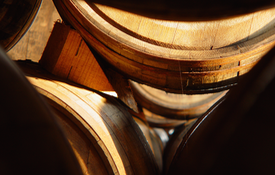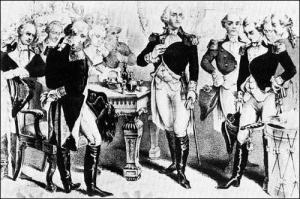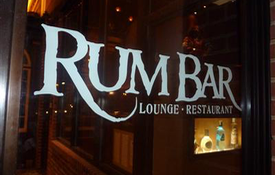
Rum Slumbering
Rum is a chameleon-like spirit; light or dark, silly or contemplative, pure and “enhanced.” It is also an amazingly versatile spirit, mixing well and often with nearly every soft drink and juice and is likely responsible for a wildly disproportionate number of blender blade rotations and burn-outs, not to mention those lovely little cocktail umbrellas.
The history of rum begins with its source ingredient, sugar. Sugarcane— a tall, thick grass native to Papua New Guinea and Indonesia—was first spread by Chinese traders who introduced it to Asia and India. Arabs brought sugarcane to the Middle East and North Africa where it caught the eye and palates of Europeans during the Crusades. Spanish and Portuguese explorers and would-be-colonialists brought sugarcane to the islands of the Atlantic, planting the crop in the Canaries and Madeira in the early 15th century and later to the New World, primarily Brazil and the Caribbean Islands. Cristoforo (oh, this isn’t India?) Colombo planted cane in Hispaniola (the island that now hosts the Dominican Republic and Haiti) and Cuba.
Rum in its many forms is the product, or by-product, of the production of sugar. Cane juice is boiled in order to encourage crystals to form for easy extraction. The remaining sweet juice that has now become thick and dark from prolonged boiling was called “melazas” from the French and Spanish word for honey, “miel,” which became molasses in English.
As we all know from Fermentation 101, if you leave a sweet liquid out in the hot tropical air the local yeast will soon feast. The fermented molasses was wild and harsh but the Europeans were wise in the ways of distillation, and stills could be devised rather quickly and cheaply. In the islands, rum was used to cure all from pains to sniffles and as “fuel” for the laborers. Soon the spirit was used as an enticement for British naval ships stationed in the Caribbean to keep nearby in order to protect the sugar merchants from pirates.

Washington served Rum at his inauguration
Rum was also becoming popular in the new North American colonies and was exchanged for goods and supplies such as hard wood lumber and salted cod. The British imperialists soon took exception to the bartering that failed to enrich the crown with tax and duty. The New England colonies adapted to this restriction by simply trading for molasses and building their own distilleries. The British responded by ordering the colonies to buy only English molasses at a premium. Tea may have been the Boston Harbor cocktail of historical note but the tariffs on molasses and Rum were an equal, if not greater, irritant.
Like most every major spirit, Rum is steeped in history, albeit largely regrettable at best. Europeans’ taste for sugar grew at a feverish pace necessitating additional Caribbean sugar plantations, further colonizing of the islands, and the need for slaves to work the fields and mills. The trading of molasses to New England colonies was the first leg in the infamous “slavery triangle.” The second stage involved the transportation of Rum to West African ports where it was traded to tribal leaders for slaves, often a convenient way for tribal leaders to get rid of their rivals. The final stage involved the shipping of slaves back to the sugar plantations of the Caribbean and South America. European nations who greatly prided themselves on their cultural evolution beyond slavery quickly betrayed their ideals in order to feed their addiction to sugar.
Rum and the sea have long been inseparable following their introduction in the steamy and sometimes dangerous ports of the Caribbean. (“Yo, ho, ho and a bottle of vodka” just doesn’t have the same ring.) Whether you were a pirate or an officer in Her Majesty’s Navy, Rum was an integral part of daily life. Until very recently (1969) British sailors were rationed a daily dose of Rum. In the eighteenth century the typical sailor would receive half a pint of high proof Rum (roughly the equivalent of nine shots of 151 proof rum each day). At home the British upper class turned to Rum, as Gin was becoming a drink associated with drunkenness and slums. In the nineteenth century, Europeans discovered how to extract sugar from sugar beets, which made sugar mills in the Caribbean less of a concern. Many small plantations and their stills were closed.

You Can Judge a Bar by its Rum
Leaping forward to post Prohibition day in the USA the drinking culture took a major shift from the dark speakeasy to the bright and festive world of the Tiki bar. Iconic bars such as Don the Beachcomber in Hollywood opened in 1934 followed quickly by Trader Vic’s (Victor Bergeron) in Oakland, CA. Both establishments lay claim to having invented the quintessential Tiki cocktail, the Mai Tai. The Mai Tai, Daiquiri, Zombie, and Painkiller among others are Tiki cocktails reliant upon Rum.
During the Second World War the availability of many spirits types became scarce save Rum. The most popular cocktail of the day was the Cuba Libre – simple, delicious, and relied on an iconically American product, Coca-Cola.
Some came the dark days of cocktails in America as expediency and convenience were the mantra of the day. Along with the TV dinner came a collection of fabricated mixers available in a range of colors not found in nature. Most great cocktails and their respective spirits took a quality hit. Perhaps Rum was injured more than most spirits categories as the spirit was so closely linked to poorly-made blender-centric drinks like the flavored Daiquiri and the Piña Colada.
Today Rum is as serious of a spirit as it has ever been. Buyers and consumers are demanding authenticity in their Rum regarding transparency of origin and purity of the juice as flavorings and added sugar are becoming taboo in the aged Rum category. This of course is a good thing and an inevitable evolution of the category as some categories (such as Whiskey, Tequila, and Bourbon to mention a few) have already had their reformations.
While 97% of the Rum produced in the world is derived from molasses with just 3% coming from sugarcane juice, Rhum Agricole is a serious subset. Rhum Agricole is produced from pure cane juice rather than molasses. Rhum Agricole is produced primarily in the French West Indies, Martinique, and Guadeloupe. These Rhums are primarily enjoyed in France although the British have caught up with Rhum Agricole in recent decades. The production, aging, and labeling are carefully controlled by the French Appellation d’Origine Contrôlée (AOC), the same system used to regulate wines and cheese.
A Note About Aging Rum – and Aged Rum

Aged Caribbean Rum Sipped Neat
First, it is vital to remember that in most Rum producing nations wood aging is required before a spirit can legally be called “Rum.” This applies to White Rum as well. Some distillers have told me that nearly 90% of a Rums flavor can be obtained via cask aging. Most Rum is matured in former Bourbon and Tennessee Whiskey casks. The laws require no specific type of cask to be used. Used Bourbon casks are in great supply as the laws governing the creation of these spirits demand that ONLY new casks are to be used.
Don’t be tempted to qualify aged Rum based on years in cask. Aged Rums are best considered in “dog years” of cask aging. Any spirit aged in a hot, humid climate is going to have far more wood interaction and extraction than would a Cognac or Scotch Whisky. Heat and humidity hasten the process.
When the wood aging of Whisky is discussed the term “Angel’s Share” is often evoked referring to the amount of spirit lost to evaporation rising to the heights of the angels. In the Caribbean the Angels are taking a greedy cut for themselves. In Scotland an average annual loss of spirit is 2% while Caribbean Rum produces can experience up to 10% or more lost in just the first year of aging. It is not uncommon to visit a cask of Rum that has aged for 7 years and find it nearly or even completely empty.
Considering the prices being asked for Scotch Whisky, Irish, and Bourbon these days aged Rum is a smart choice to fill your brown spirits needs.
Rum offers something for everyone, the consummate “spirited” politician bending to please any audience it should encounter.
